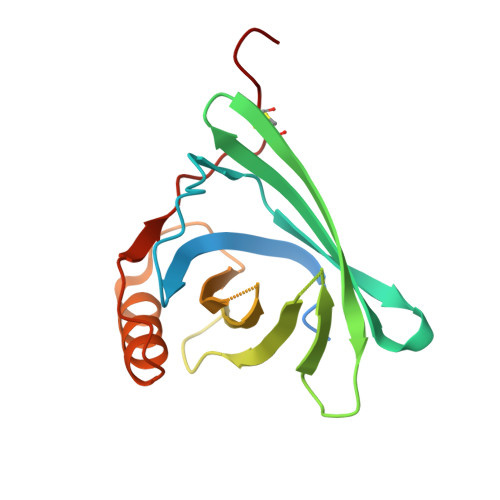Structure-based prediction of the IgE epitopes of the major dog allergen Can f 1.
Nakatsuji, M., Sugiura, K., Suda, K., Sakurai, M., Ubatani, M., Muroya, H., Okubo, R., Noguchi, R., Kamata, Y., Fukutomi, Y., Ishibashi, O., Nishimura, S., Inui, T.(2022) FEBS J 289: 1668-1679
- PubMed: 34699686
- DOI: https://doi.org/10.1111/febs.16252
- Primary Citation of Related Structures:
7DRU - PubMed Abstract:
Allergy to dogs has become increasingly prominent worldwide. Seven dog allergens have been identified, including Canis familiaris allergen 1-7 (Can f 1-7). Although Can f 1 is a major dog allergen sensitized to 50-75% of dog-allergic subjects, its IgE epitopes have not been identified. The structural analysis of an allergen is important to identify conformational epitopes. In this study, we generated a recombinant Can f 1 protein and determined its crystal structure using X-ray crystallography. Can f 1 had a typical lipocalin fold, which is composed of an eight-stranded β-barrel and α-helix, and has high similarity to Can f 2, Can f 4, and Can f 6 in overall structure. However, the localizations of surface charges on these proteins were quite different. Based on sequence alignment and tertiary structure, we predicted five critical residues (His86, Glu98, Arg111, Glu138, and Arg152) for the IgE epitopes. The relevance of these residues to IgE reactivity was assessed by generating Can f 1 mutants with these residues substituted for alanine. Although the effects of the mutation on IgE binding depended on the sera of dog-allergic patients, H86A and R152A mutants showed reduced IgE reactivity compared with wild-type Can f 1. These results suggest that Can f 1 residues His86 and Arg152 are candidates for the IgE conformational epitope.
Organizational Affiliation:
Department of Applied Life Sciences, Graduate School of Life and Environmental Sciences, Osaka Prefecture University, Sakai, Osaka, Japan.














